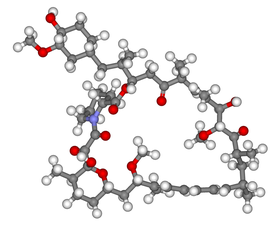MTOR inhibitors
| mTOR inhibitors | |
|---|---|
| Drug class | |

Ball-and-stick model of sirolimus, the prototype mTOR inhibitor
|
|
| Class identifiers | |
| Use | Immunosuppression (rapamycin) |
| Mechanism of action | mTOR inhibition |
| Biological target | • FKBP12 • mTOR |
mTOR inhibitors are a class of drugs that inhibit the mechanistic target of rapamycin (mTOR), which is a serine/threonine-specific protein kinase that belongs to the family of phosphatidylinositol-3 kinase (PI3K) related kinases (PIKKs). mTOR regulates cellular metabolism, growth, and proliferation by forming and signaling through two protein complexes, mTORC1 and mTORC2. The most established mTOR inhibitors are so-called rapalogs (rapamycin and its analogs), which have shown tumor responses in clinical trials against various tumor types.
The discovery of mTOR was made a few decades ago while investigating the mechanism of action of its inhibitor, rapamycin. Rapamycin was first discovered in 1975 in a soil sample from Easter Island of South Pacific, also known as Rapa Nui, from where its name is derived. Rapamycin is a macrolide, produced by the microorganism Streptomyces hygroscopius and showed antifungal properties. Shortly after its discovery, immuosuppressive properties were detected, which later led to the establishment of rapamycin as an immunosuppressant. In the 1980s, rapamycin was also found to have anticancer activity although the exact mechanism of action remained unknown until many years later.
In the 1990s there was a dramatic change in this field due to studies on the mechanism of action of rapamycin and the identification of the drug target. It was found that rapamycin inhibited cellular proliferation and cell cycle progression. Research on mTOR inhibition has been a growing branch in science and has promising results.
...
Wikipedia
